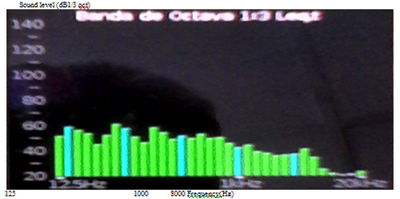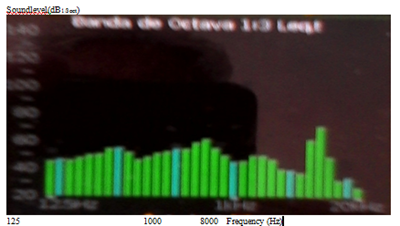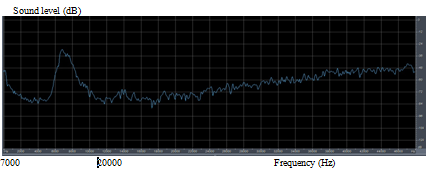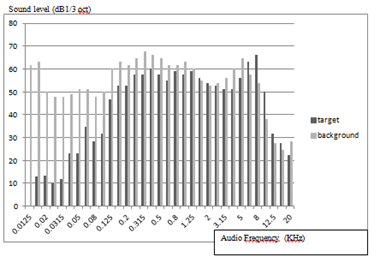MOJ
eISSN: 2379-6383


Research Article Volume 8 Issue 4
Environmental Health & Epidemiology Center, Cuba
Correspondence: Carlos Barcelo Perez, Risk assessment Department, Environmental Health & Epidemiology Center, 354, 5th street, Dpt 9, Plaza, Havana, Cuba, Tel 53-78312705
Received: March 27, 2019 | Published: July 19, 2019
Citation: Perez CB, Sanchez YG. Non usual urban sounds in a western neighborhood of Havana city. MOJ Public Health. 2019;8(4):130-134. DOI: 10.15406/mojph.2019.08.00297
Main noise source in the city of Havana is road traffic, but many noise complaints are connected to a mechanical source and audio exposures as level induced from air conditioners or fun which escapes from entertainment places. Last year some complaints by noise exposure to the so called “noise attacks” were referred by American diplomats. This paper intends to present a sound characterization of possible noise events experienced including audible structure of this acoustic episodes (target sound). Article could contribute to clarify nature of the so-called noise attacks which have worsened the diplomatic relations between the United States and Cuba. Some recordings of the target sound supplied were assessed and also, background noise was featured through sound level measurements. It was watched that background noise at night is connected several times to presence or absence of crickets calls in green spaces at a residential neighborhood, Western of Havana. Target sound is described on behalf its possible noise level and frequency structure, by two main shapes, one of them reflects a broadband noise with a high pitch overlapped. The other one has no high frequency (pitch). Several target sounds episodes recorded show certain likeness to the background noise with cricket sounds added. Ultrasounds and microwaves are not supported as source of target sounds connected to noise attacks. Sound estimated levels and frequency structure do not support hypothesis of induced health impairment. Sometimes target sound level is weak, close to background. Directional sound seems not able to penetrate isolated built environment.
Keywords: noise attacks, infra-and ultrasound, noise, background sound, sound spectrum, pitch
On the view of health and sustainable development it is important to keep in mind the vision of healthy environments as a way to risk assessment and health promotion for life quality. Because growing urbanization process, it should be important to consider what a healthy city is. A healthy city has been defined as one that is continually creating and improving those physical and social environments and expanding those community resources which enable people to mutually support each other in performing all the functions of life and in developing to their maximum potential.1 Struggling for a healthy city means identification and managing of environments to reduce exposure to health risk factors and then to provide alternatives addressed to cope with challenges related to human settlements. Among physical risk factors it will be necessary to deal with noise events.2 Sound and noise exposure are connected not only to pleasant sensations but also to psycho somatic dysfunctions which are often reflected as annoyance and complaints.3 Moderate intensity sounds may be associated mainly to non-auditory effects.4 Sound as a wave set of pressure which propagates in an elastic media encompass infra-sounds with frequencies below 20Hz. Human exposure to high infrasound levels could be associated to annoyance, sleep disturbances, headache and concentration handicaps in adult population.5
Ultrasounds refer sound waves with frequencies above 20kHz. Sometimes they seem to induce non specific psycho-somatic effects and in cases hearing loss associated to high frequencies and strong in-missions.6
It was recently pointed out that a sound directional phenomena is connected to the before mentioned episodes. 18/21 people studied declares noise exposures, 3/21 do not perceived noise and there is no absolute coincidence in the possible pitch associated, however high pitch criteria prevails.7 So, sound projectors have been described,8 directional speakers9 and, so on. Modernly, ultrasound has been tested as a directional transmission tool conducting sound waves in a narrow beam.10 any way; ultrahigh frequencies become attenuated and easily interfered by physical barriers, so that an ultrasonic beam does not achieve propagation by long distances. Moreover, it was written that under usual conditions there are no harmful associated effects. So, it means that this resource is not suitable for a “noise attack”.11
Human hearing encompass perception of sound waves for frequencies in the region 20-20000Hz. Temporary and permanent aural threshold shifts could be produced in humans from higher doses of exposures. Several impairments are connected to a dose-response relationship. Hearing loss (deafness) could be consequence of long term occupational exposure (sensor neural damage). But there exists agreement on a mechanism to achieve a sudden permanent aural threshold shift after exposure to a high intensity above 120dB (spl) of impulse noise.
Any sound could produce a first reaction (orientation and awakening). Considering moderate intensity sounds -above 60 until 80dB(A)-it could be possible to suffer an aural effect for a while -cited as a loss of hearing acuity or temporary threshold shift (TTS)- because trend to recover sensitivity just soon after exposure, including so called stapedial reflex, which performs an ear protection due to increased impedance at middle ear. When exposure lasts long enough (years) at high intensity level –above 85dB (A), acuity reduction could be progressive and permanent, producing a permanent aural threshold shift (PTS). From public health standpoint several exposure limits have being established for occupational and public scenarios. For instance, maximum allowable suggested "sound levels – time exposure" on behalf NIOSH recommendations for workers.
In spite of scarce use of sonic weapons, it should be feasible to mention them as possible source of non-usual sound events.12
Main urban noise source in Cuban cities is road traffic. Complaints however come mainly related to fan and air conditioner devices and, music that get away from entertainment places. Research on local public exposure to environmental noise reveals some health impacts of urban noise in Cuban population. For instance, some possible noise exposure effects on housewives are expressed as an ecological functional relationship between noise level and subjective perception, anxiety and annoyance.13
Some possible non usual sound episodes have been recently reported in the media and described as “noise attacks” (target sounds) by States diplomats at Havana. These episodes were informed to Cuban authorities, first time, by February 2017. Tackling a first approach, goal of this paper is to describe these noise events from scope of environmental health.
On behalf of describing non usual sound episodes, attributed to some American diplomats who refers them, not in the work place but in their housings, were mainly perceived in residences and surroundings in Havana, field measurements of background noise in a neighborhood Western of Havana city were leading and, sound event recordings were assessed too, which last from seconds to few minutes. Reproduction level of recordings was never saturating the audio channel. There were some uncertainties on regard measurements weighted sound pressure levels because not one of available recordings appeared calibrated for reproduction. So, there were several background measurements and target sound recordings analyzed.
Measurement of integrated sound level (LeqA, Lmax, Lmin), complementary percentile values and spectral auditory structure (lineal & third octave) were obtained using a sound level meter Optimus 1 CR 171B, manufactured by Cirrus Research, U.K. Air calibration with a kHz tone at a level of 93,7dB(spl) was provided before and after measurement sessions using CR 515 piston- phone. Continuous spectra of physical concern were also performed and assessed. Those mentioned spectra were obtained using Adobe Audition, a software tool for analysis and processing of audio signals. Using FFT filters, it was feasible to choose audio bands of interest to be displayed. Signals were evaluated in the time domain and in the frequency domain. Analysis in the frequency domain allows appreciating the continuous spectrum of the signal and the amplitude of their fundamental components as well as the level intensity and composition of the frequency content of the signal visualizing them as a cascade.
Considering working screen in time domain it is possible to appreciate how the AD converter codes the samples and the occupation percentage of the available code space. Occupation of the code space, always below 30%, indicates the absence of strong signals at the microphone input of the recording element. Because episode of June 8 is represented by several target and background samples, it was used log-antilog averages to resume analysis outputs.
Background noise
The so called “noise attacks” seem to happen at night time. Considering neighborhood in the residential area of diplomat housings, nature of its background noise is composed by far road traffic, heat exchangers of air conditioners, remote pet noises like barking of dogs, cheeping of birds, steps in motion and human voices far away. Sometimes cricket sounds rule over other sound sources. Sound levels of background (1∕3) ( fc 21∕2 – fc 2−1∕2) was used covering human audible frequency range, where fc is center octav band frequency, of an hourly sound sample at 10 o´clock night seems to be mainly composed by low and middle audio frequencies (human audio region contains 10 octav bands, imitating sensitive composition of human audition, sum of 10 octav bands intensity) at 10 o´clock night seems to be mainly composed by low and middle audio frequencies (human audio region contains 10 octav bands, imitating sensitive composition of human audition, sum of 10 octav bands intensity cover audition range) then background sound event structure is shown in Figure 1. This is purely a cosmopolitan background noise without sensitive contribution of local sources. It is seen that no important energy related to high frequency lies in the spectrum.

Figure 1 Spectrum of Third Octave band sample of hourly background noise without cricket emissions in a western residential neighborhood of Havana City at 10 o´clock night-time.

Figure 2 Third Octave band sample of hourly background noise including cricket sounds in a western residential area of Havana City at night time.

Figure 3 Lineal sound spectrum of background noise including cricket sounds during night-time outdoors in a residential neighborhood Western of Havana.
According to Table 1 it is possible to consider an inter-percentile dynamic range (P05–P95) of 34,5 dB(A,F), which reveals a non-continuum (fluctuating) performed sound field. Sound level of target sounds episodes generally remains moderate or weak in intensity. So, it is difficult to believe that a “noise attack” is taking place during noise exposure. This way, no permanent impact on health could be expected. Differences on regard background are not clear at all. Severe exposure to an intense sound level was not identified in a target sample recording, nor in background noise measurements either. It is meant, anyway, no impulse noise was clearly identified.
Complementary percentile of sound level |
Percentile sound level [dB(A, F)] |
1%(peak) |
75,2 |
5%(peak) |
74,5 |
10% |
74,2 |
50% |
63,8 |
90% |
42,9 |
95%(bottom) |
40,0 |
99%(bottom) |
38,5 |
Table 1 Complementary percentile values of an hourly sound level sample from background which include sound episodes produced by Orthoptera calls during night time, coming from an open greenfield site in a residential area Western of Havana
There exist some kind of similitude between background noise with cricket sounds and this target sound spectrum. It would be interesting to explore concomitant differences among spectra of target noise and the background. Figure 5 which is a sample of an episode of June 8, suggests that target sound–possible heard at a housing- is sometimes characterized by high frequency predominance, instead background noise–possible heard outside- is connected to more energized low and middle audio frequencies. As a matter of fact, it would be possible to confirm again a 7 kHz pitch in the lineal spectrum of Figure 6. Watching (Table 2) it is possible to observe that again dynamic of target sound with high pitch content does not statistically rise beyond 80dB (A,F), so no permanent health outputs are possible to foresee.

Figure 5 Comparison of third octave band structure of target sound and background noise through synchronous samples in a Western neighborhood of Havana city at night time.
Complementary sound level percentiles (%) |
Sound level in dB(A, F) |
1(peak) |
76,3 |
5(peak) |
75,9 |
10 |
75,6 |
50 |
74,1 |
90 |
71,9 |
95(bottom) |
70,5 |
99(bottom) |
58 |
Table 2 Complementary percentile values of outdoor sound levels connected to target sound of June 8 episode considering three independent samples. Values were obtained from log antilog averages

Figure 7 Third octave band sample of a target sound episode without high pitch according recording supplied.
The dynamic of this sample, according to Table 3, allows appreciating the proximity of sound levels of the target sound to the expected acoustic background. The values were obtained by processing individual samples. Not only the minimum percentiles but also peaks do not significantly move away from the acoustic background.
Complementary percentile of sound level dynamic (%) |
Sound level in dB(A, F) |
1(peak) |
67,2 |
5(peak) |
63,0 |
1000% |
61,6 |
5000% |
56,6 |
9000% |
52,9 |
95(bottom) |
52,2 |
99(bottom) |
51,7 |
Table 3 Complementary percentile values of sound levels connected to target sound at July 12. Values were obtained processing individual sampling
Overall observations
General sound level range of target episodes moves from 49, 6 to 75, 2dB (A, F). Target noise events last between some minutes to less than an hour attending recordings. Equivalent continuous level of fluctuating noise (Leq) remains in the episode set from 58,8 to 74,2dB(A, F), Lmax extends from 69,7 to 76,9 dB (A,F) and from 87,1 to 93dB (spl,p) for peak time sound resolution (35µsec). On regard background noise, sound level range of background moves from 42, 9 to 81, 3dB (A, F). Leq remains around 69, 2dB (A, F), Lmax around 85,1 dB(A,F). Sometimes target sound pressure level- -A weighted- of sound samples are near or close to background noise. This way, target and background noises qualify as weak to moderate on behalf intensity. On spectral shapes, a 7kHz pitch often appears, but was not ever present. Five samples of 8 show a peak in the 7 kHz area; three of 8 let see some infrasound content near audio threshold without peak.
It is not unanimous possible clue of significant infrasound near threshold in the third-octave spectra related to the episodes. Without weak infrasound there were 4 of 10 analyses. Two of five third octave spectra share a Peak with infrasound content above 12Hz and, two of four samples assessed, raise a Peak without infrasound content.
The estimated sound levels of target were weak to moderate in intensity -below 80dB(AF)- within a margin of uncertainty cause lack of recording sound reference. At extremes of the sound structure no high intense pitches (no peaks) appeared in the lineal spectra, so presence of non-audible sound components can be ruled out.
If target sound is connected to a microwave exposure, then its nature should be subjective -something like a Frey effect,14 whose objectible nature is nonexistence.
Otherwise, the existence of ultrasonic inter modulation has been hypothesized,15 but this would not occur unless ultrasound sources were located in housing indoors with very specific defined frequencies because ultrasound can hardly penetrate house enclosures designed with sound isolation for air conditioning purposes, because high frequency pressure waves would be absorbed quickly and, a huge diffusion power amount would be needed to ultrasound waves for built environment penetration and human affectation without the neighbors being involved and, no neighbor declares exposure to non usual sounds. So not only audible, but also non audible sounds are dismissed as sources of noise attack.
Although strong directionality of sound beam seems to be technically difficult, its possible existence is hard to be sustained. Because nobody else in residential neighborhood, but diplomats, declares hearing non usual sounds, it should be accepted possible high directionality of sonic beam.
On regard microwave hypothesis, an observation would be, if target sound is a subjective experience, what is the origin of associated recordings delivered for assessment? Several unusual sound episodes are shown as broadband spectra where apparently a cosmopolitan acoustic background is combined with possible high frequency pitches similar to those produced by some kind of Orthoptera.
Five samples of 8 contain a peak near 8kHz; 3 of 8 showed some infrasound component without ostensible tonal component. It is not unanimous possible evidence of significant infrasound in the third-octave spectra related to target sound episodes. Without significant infrasound (below 40dBA) there were 4 of 10 analyses. Two of 5 third octave spectra share a Peak with infrasound above 12Hz. The estimated target sound levels are no more than moderated in intensity below 80dB(AF), background.
When a wide broadband co-exists with a high frequency pitch as it is known noisiness become higher. However, energy was not so intense in the assessed cases for thinking in a permanent health impairment related to exposure that leads to reject aural or nervous consequence, considering short time elapsed episodes. This way permanent health impairment associated to target sound should be dismissed.
Considering possible noise directionality, as former mentioned, the field of sound propagation is enabled to introduce sensitive alterations in the dispersion of sound waves. Considering structural isolation of fully air-conditioned houses, penetration of weak intensity sound becomes a controversial issue.
When pressure waves are focused towards the constructed space, presence of building envelopes and roofs can hinder transmission of ultrasound waves or directional sound to the interiors, therefore these technologies would reduce their effectiveness when sources are located at outdoor space of the built environment and, when from external locations it is intended to penetrate the construction materials.
Finally, it is really important to understand that this so called ¨noise attacks¨ assumes political meaning and contributed to rarify close up atmosphere that avoids attempt to perform desirable civilized and respectful friendship among countries. Discarded sound phenomena as cause of reported disturbances, it should be necessary to extent research looking for explaining aethiology of a wide range of affectations to chosen people, converted suddenly in patients.
None.
Author declares their are no conflicts of interest.
None.

©2019 Perez, et al. This is an open access article distributed under the terms of the, which permits unrestricted use, distribution, and build upon your work non-commercially.